Canale L.C.F., Mesquita R.A., Totten G.E. Failure Analysis of Heat Treated Steel Components
Подождите немного. Документ загружается.

treating conditions based on the criterion of
minimum dimensional deviations, that is, mini-
mum workpiece distortion. Currently, measure-
ment of individual workpiece dimension is a
very practical, uncomplicated, and reliable
method of product quality assessment. Through
the appropriate selection of the grinding wheel
and grinding conditions and taking into account
the physical and mechanical properties of the
workpiece material, very favorable compressive
residual stresses in the hardened surface layer
can be retained.
How is it possible to assure a desirable surface
and surface layer quality after induction hard-
ening and fine grinding? Finding an answer to
this question requires a very good knowledge of
the grinding process on the microlevel as well as
knowledge of mechanical and heat effects acting
on the layer of the workpiece, including the type
of grinding wheel and the grinding conditions.
An all-inclusive consideration of the numer-
ous influences of the tool type and condition on
the changes on the surface and in the surface
layer of the workpiece in the given machining
conditions is described by the term surface
integrity. This is a scientific discipline providing
an integral assessment of the surface and sub-
surface layer. It was defined at the beginning of
the 1960s. For high-quality machine parts and
parts subjected to heavy thermomechanical
loads, different levels of description of the sur-
face integrity were defined. A basic level of the
surface-integrity description includes measure-
ment of roughness and analysis of the micro-
structure and microhardness in the thin surface
layer resulting from the machining process
under given machining conditions. The second
level of the surface-integrity description in-
cludes studies of residual stresses in the surface
layer and of mechanical properties of the given
material. The third level of the surface-integrity
description includes tests making clear the be-
havior of the given part under the operating
conditions.
As essential advantage of induction surface
hardening is that it is possible to achieve a suf-
ficient repeatability of the hardened layer thick-
ness on the workpiece as well as a desirable or
even prescribed hardened layer profile, ensuring
sufficient hardness and favorable distribution
of residual stresses in the hardened layer. A
variety of steels and a whole range of induction-
hardening methods provide the possibilities
for very accurate planning of residual stress size
and distribution. This is of growing importance,
since manufacturers are frequently required to
produce machine parts that, among other surface
properties, must have quite specific residual-
stress distribution along the depth of the hard-
ened layer. It has become a proven fact that high
compressive stresses ensure high fatigue
strength of machine components and reduce the
danger of crack occurrence and growth on the
surface of components.
In thermal hardening, the surfaces of suitable
materials, usually plain carbon, low-alloy steels,
or cast irons, are austenitized and then quenched
to produce a hard martensitic case that is usually
tempered in a subsequent operation. Case depths
are normally in the range of 0.5 to 5 mm. Case
hardness is typically approximately 700 HV on
hardening and 600 to 650 HV after tempering at
200
C (Ref 1).
Heating processes include electrical induction
and resistance (Ref 2–4), and direct impinge-
ment methods using flames, (Ref 5), lasers
(Ref 6–11), and electron beams (Ref 12). Of
these, induction heating is the most widely used.
Laser and electron beam heating have recently
become established in a number of applications,
mainly where distortion was a problem with the
induction method.
Thermal treatments are mainly employed
when only local areas on machine parts require
hardening and wear resistance. Consequently,
such methods are energy efficient compared
with thermochemical methods where bulk heat-
ing of batches of components is undertaken.
Normally, the surface-hardening process also
introduces compressive stresses into the surface
layers, leading to an improvement in fatigue
properties. For example, the drive shafts of
heavy lorries and buses are induction surface
hardened to improve their fatigue properties
(Ref 10, 11).
The skills and experience required for manual
flame hardening have been largely superseded
by automated flame techniques or by the in-
duction method. However, for one-off machine
parts, the simplicity of manual flame hardening
and the extremely low capital investment ensure
that the method is still used on a regular basis
(Ref 5, 13).
From a heat treatment point of view, laser can
be considered as a versatile and flexible high-
intensity heat source that can operate in air. It is
capable of undertaking a range of processes,
essentially simultaneously, since the laser beam
can be directed through air by metal mirrors and
switched and shared among a number of work
418 / Failure Analysis of Heat Treated Steel Components
Name ///sr-nova/Dclabs_wip/Failure_Analysis/5113_417-501.pdf/Chap_13/ 18/8/2008 3:58PM Plate # 0 pg 418
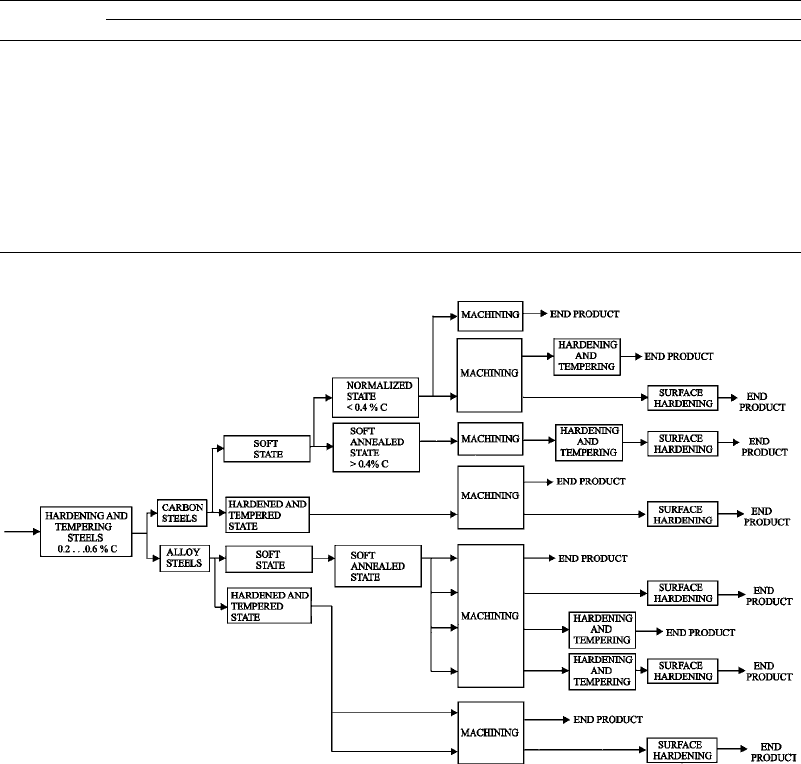
stations. Manipulative techniques using mirrors
allow the beam to be directed to areas not
accessible by other techniques, for example, the
bores of tubes. Set against these considerations
are the high capital cost and low energy effi-
ciency of the technique (Ref 1, 6, 10).
Steels for Surface Hardening
Heat treatable steels contain between 0.2 and
0.6% C and can be carbon steels or low-alloyed
steels (Table 1) (Ref 14, 15).
In practice, engineers choose these steels
because, in the soft condition (normalized or soft
annealed), they are more suitable for machining,
while their strength properties and hardness can
be subsequently refined by additional heat
treatment. Soft steels have good machinability,
while additional heat treatment improves their
mechanical properties to a desirable level.
Figure 1 presents a schematic of the heat treat-
ment methods used to achieve the desired
mechanical properties (Ref 15, 16). Besides the
mentioned surface hardening, other thermo-
chemical methods can be used to create a de-
sirable wear resistance. The steels for surface
hardening are from the group of heat treatable
steels, except that they usually contain between
0.35 and 0.5% C. Heat treatable steels can be
Table 1 Suitable steels for induction surface hardening
Type of steel
Chemical composition %
C Si Mn P, max S, max Cr Mo Ni
1 0.33–0.39 0.15–0.40 0.50–0.80 0.035 0.035 ... ... ...
2 0.38–0.44 0.15–0.40 0.50–0.80 0.035 0.035 ... ... ...
3 0.43–0.49 0.15–0.40 0.50–0.80 0.035 0.035 ... ... ...
4 0.48–0.55 0.15–0.40 0.60–0.90 0.035 0.035 ... ... ...
5 0.50–0.57 0.15–0.40 0.40–0.70 0.035 0.035 ... ... ...
6 0.42–0.48 0.15–0.40 0.50–0.80 0.035 0.035 0.40–0.60 ... ...
7 0.34–0.40 0.15–0.40 0.60–0.90 0.035 0.035 0.90–1.20 ... ...
8 0.38–0.44 0.15–0.40 0.60–0.90 0.035 0.035 0.90–1.20 ... ...
9 0.38–0.44 0.15–0.40 0.50–0.80 0.035 0.035 0.90–1.20 0.15–0.30 ...
10 0.38–0.44 0.15–0.40 0.70–1.00 0.035 0.035 0.40–0.60 0.15–0.30 0.40–0.70
11 0.37–0.43 0.15–0.40 0.50–0.80 0.035 0.035 0.60–0.90 0.15–0.30 0.70–1.00
Source: Ref 14, 15
Fig. 1 Heat treatment methods for carbon and low-alloyed steels. Source: Ref 15
Induction Hardening / 419
Name ///sr-nova/Dclabs_wip/Failure_Analysis/5113_417-501.pdf/Chap_13/ 18/8/2008 3:58PM Plate # 0 pg 419
supplied in soft or refined conditions. Carbon
steels with less than 0.35% C are in the nor-
malized condition, and the products made from
them can be in the soft or refined condition. For
improvement of the wear resistance of these
steels, additional surface hardening can be
applied (Ref 14, 17, 18).
Below 0.35% C, the treated surface is insuf-
ficiently hard, and above 0.6% C, there is a
danger of surface cracking after quenching. To
obtain a satisfactory hardening response in
induction surface hardening, it is necessary for
the carbides to dissolve when the steel is heated.
Thus, steels that have been quenched and tem-
pered and have small carbide particles respond
better than steels with large spheroidized car-
bides. Similarly, the rate of solution of carbides
in steels other than plain carbon and low-alloy
steel is too slow for them to be satisfactorily
induction hardened. Steels must also have suf-
ficient hardenability to achieve the required
hardness at the specified depth (Ref 17).
The procedures are similar for fabrication of
machine parts made of carbon steels with more
than 0.35% C and alloyed steels, expect that
because of the higher machinability required,
they must be in the soft-annealed condition.
For induction surface hardening, it is recom-
mended to use steels with an appropriate carbon
content (0.35 to 0.45%) and a careful selection
of alloyed elements. Usually, these steels have
an increased silicon (0.15 to 0.40%) and man-
ganese (0.50 to 1.00%) content and other
alloying elements, such as chromium, moly-
bdenum, and nickel. More highly alloyed tool
steels (O1, D2, D3, A1, and S1) and some mar-
tensitic stainless steels (AISI 416, 420, and
440C) are also sometimes induction hardened.
Among alloyed steels, chromium, chromium-
molybdenum, and chromium-molybdenum-
nickel steels prevail. With given combinations of
alloying elements in induction-hardened mach-
ine parts, the internal stresses in heating as well
as in cooling can be controlled. The steels are
normally quenched in water. In certain cases, the
alloy steels can be cooled by means of an oil
emulsion. Steels can also be oil quenched. Hav-
ing selected the right shape of the product and the
right choice of technology, it is possible to
expect only minimal distortions of the workpiece
after completion of the heat treatment (Ref 14).
If the starting points are the hardness and
residual-stress profiles, then the induction-heat-
ing conditions should be adapted to the selected
steel. Induction heating of a machine-part
surface to the austenitic zone above T
A
3
is of
major importance, since not only the case depth
but also the right through-depth residual-stress
and microhardness profiles of the machine part
are to be provided. The through-depth micro-
hardness profile of the surface layer depends,
with the given steel, on the induction-hardening
conditions. Induction heating may be controlled
by infrared thermometers. An infrared thermo-
meter is placed close to the induction coil, which
means that only the maximum surface temper-
ature may be measured. This technique is quite
simple and practical. It allows a user to determine
the required, that is, optimal, power density for
heating. When a multiturn coil is used, for
example, with longer workpieces, several infra-
red optical-fiber thermometers may be em-
ployed. Thus, with sufficient spacing between
two adjoining turns, the temperature may be
measured at different locations on the machine
part. A difficulty may arise due to nonuniform
heating along the coil movement. By collecting
and processing the gathered measurement data,
the process quality may be assessed. In scientific
research, temperature measurement with
thermocouples may be applied too. In induction
surface heating, temperature measurement using
thermocouples is quite exacting, since they are
embedded in the machine part. The hardened
state of steel is to be obtained at an appropriate
depth. The thermocouples embedded at a parti-
cular location in the workpiece permit tem-
perature measurements at this location only. In
progressive hardening, however, the momentary
temperature is measured. Thus, the so-called
temperature cycles in heating, as well as in
cooling, are obtained. The temperature cycles
make it possible to predict the efficiency of sur-
face hardening. The choice of energy input, that
is, power density, in an appropriate nomogram,
that is, the choice of power and heating time with
reference to the shape of the induction coil and
case depth, applies only to stationary heating and
hardening of machine parts. This means that in
progressive hardening the data obtained on the
energy input are of informative character only.
Main Features of Induction Heating
Induction heat treatment is a segment of the
much larger technical field of induction heating,
which combines many other industrial processes
using the phenomenon of heating by induction
(Ref 1, 16, 18–22).
420 / Failure Analysis of Heat Treated Steel Components
Name ///sr-nova/Dclabs_wip/Failure_Analysis/5113_417-501.pdf/Chap_13/ 18/8/2008 3:58PM Plate # 0 pg 420
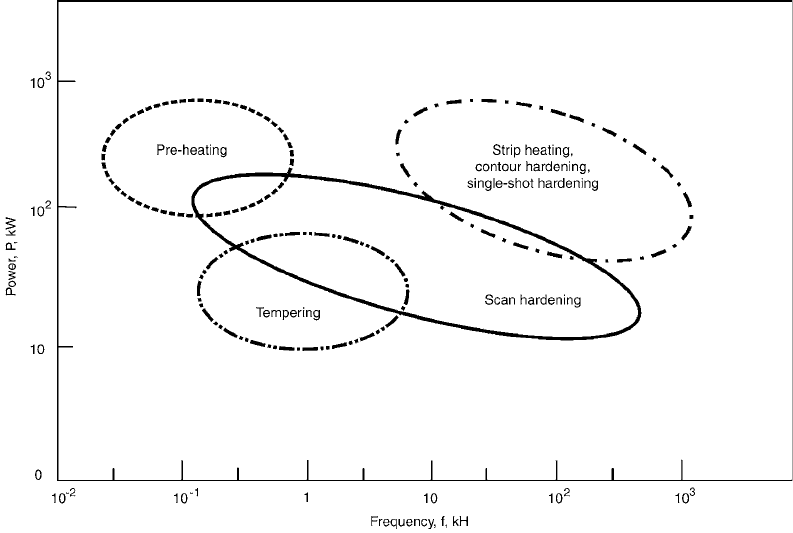
Induction heating is often one of the most
effective heat treatment processes available for a
variety of applications, including:
Surface hardening
Through hardening
Tempering and stress relief
Annealing and normalizing
Grain refinement
Precipitation hardening or aging
Sintering of powdered metals
In most of these applications, induction
heating is used to selectively heat only the por-
tion of the workpiece that requires treatment
(Ref 2). This usually means that the process can
be accomplished in a relatively short time and
with high efficiency, because energy is applied
to the workpiece only where it is needed.
One of the main features of induction heating
compared with conventional heating procedures
is that heat is generated in the workpiece itself.
In conventional heating procedures, the heat
input achieved is only 5 to 200 kJ/m
2
s energy,
whereas in induction heating this energy input
is 300 MJ/m
2
s. In induction heating, heat
penetrates into the workpiece by the aid of
high-frequency alternating current, the choice of
frequency depending on heating requirements.
Induction heating power supplies are frequency
changers that convert the available utility line
frequency power to the desired single-phase
power at the frequency required by the induction
heating process. They are often referred to as
converters, inverters, or oscillators, but they are
generally a combination of these. The converter
portion of the power supply converts the line
frequency alternating current input to direct
current, and the inverter or oscillator portion
changes the direct current to single-phase alter-
nating current of the required heating frequency.
Many different power supply types and
models are available to meet the heating require-
ments of a nearly endless variety of induction
heating applications (Ref 21, 22). The specific
application will dictate the frequency, power
level (Fig. 2), and other inductor parameters
such as coil voltage, current, and power factor
(cos Q)orQ factor (Ref 15, 19).
Advantages in Surface Hardening of
Machine Components. Induction hardening
is most often used for surface hardening of
machine components and has the following
Fig. 2 Typical power-frequency regions of induction heat treatment applications. Source: Ref 15, 19
Induction Hardening / 421
Name ///sr-nova/Dclabs_wip/Failure_Analysis/5113_417-501.pdf/Chap_13/ 18/8/2008 3:58PM Plate # 0 pg 421
advantages over other procedures (Ref 2,
19–22):
Relatively short heating times
Heating procedure is not strictly governed
by hardening temperature. All that matters is
that the heating process does not end at too
low a temperature, because sometimes it is
necessary for the transformation into auste-
nite. The heating temperature is limited by
the solidus-line temperature, since the pro-
cess is carried out while the material is in the
solid condition. Due to a short heating time,
there is no danger that the austenite grains
would grow at higher austenitization tem-
peratures, which also means there is no
danger of coarse and brittle martensite for-
mation.
The quenching procedure is easy to perform,
contributing to short surface-hardening
times. In progressive induction hardening, a
spray coil is located directly below the in-
ductor and quenches the heated surface. In
single-shot hardening, the inductor is de-
signed to perform the function of heating as
well as quenching. The coil around the work-
piece functions as an inductor in the heating
phase. After the austenitization temperature
has been reached, the current is interrupted,
and the coil functions as a spray for
quenching.
Induction hardening is a short procedure that
does not require any additional protection
against oxidation. Thus, compared with
other similar procedures, such as cementa-
tion, it does not require much subsequent
machining.
Due to the nature of the procedure, the
workpieces, especially if symmetrically
shaped, are less susceptible to undesirable
deformations after induction hardening. The
volume changes in the workpieces after hard-
ening the surface layer can be very accurately
predicted or estimated. The volume changes
after induction hardening of thin layers are so
small that quite often the function of the
machine component is not affected.
Especially in induction hardening of thin
layers and workpieces with low mass, it is
possible to achieve the desired critical rate of
cooling by self-cooling in air alone, that is,
by heat conduction from the heated surface
layer into the remaining cold part of the
workpiece. With thicker layers and work-
pieces of greater mass, it is necessary to use
quenching agents that move the actual
cooling rates close to the critical cooling
rate. These requirements can be met with the
right selection of quenching oils or polymer
water solutions. Practical experience has
shown that polymer water solutions are very
suitable for quenching of induction-heated
surfaces, since optimal quenching can be
ensured with the right choice of concentra-
tion of the polymer water solution.
The induction-hardening procedure enables
the engineer, by simply adapting the shape
of the induction coil, to ensure the desired
shape of the hardened profile of the surface
layer. Likewise, the engineer can surface
harden only that part of the surface (local
hardening) on which a certain increased level
of hardness and wear resistance is desired.
One of the main advantages of induction
hardening is the possibility of hardening a
surface layer only in certain places, at a
defined penetration depth and shape.
These advantages make it possible for
induction hardening to be fully automated
and are especially suitable for a large series
of workpieces.
Induction hardening always leaves com-
pressive residual stresses in the surface layer,
which makes machine components more
resistant to dynamic loads. Compressive
residual stresses in the surface layer after
induction hardening prevent the occurrence
of cracks in dynamically loaded components
and prevent the growth of existing cracks
on the workpiece surface, if these are present
due to hardening or grinding.
Induction hardening is appropriate for small-
sized workpieces, since, by a well-chosen
technology of heating and cooling or quen-
ching, a hardened surface layer and a refined
core can be ensured. Thus, the required wear
resistance of the machine component at a
certain location as well as the required load-
bearing capacity of the component can be
created, experiencing only a slight loss in
toughness of the core.
Induction Hardening of Machine Parts
Working Coil and Procedure during
Induction Hardening. Methods of induction
hardening of thin surface layers are always
adapted to the product size and shape and the
422 / Failure Analysis of Heat Treated Steel Components
Name ///sr-nova/Dclabs_wip/Failure_Analysis/5113_417-501.pdf/Chap_13/ 18/8/2008 3:58PM Plate # 0 pg 422
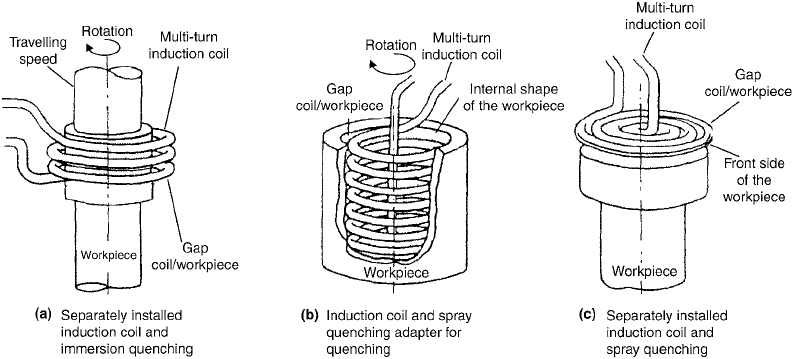
requirements of location, size, and shape of the
hardened layers profile.
Designing an induction coil, however, is very
specific to a given application and can be con-
sidered the most important aspect of the engi-
neering of the system. There are several major
functions that an induction coil must perform to
make a job successful:
Induce current in the load so that the proper
heating pattern is obtained
Accomplish the proper heating pattern with
as great an efficiency as possible
Provide an impedance match to the gen-
erator so that adequate power can be trans-
ferred to the load
Have a geometry that will accomplish the
aforementioned three major functions and
permit easy loading and unloading of the
part being heated
First, the outer and inner surface on machine
components must be distinguished. The size and
shape of the induction coil must be adapted to
the size and shape of the product, and during the
heat treatment process, the distance should be
adapted to the workpiece. It is important that the
design of the machine component be planned for
induction-hardening specifics. A uniform gap
size between the induction coil and the work-
piece surface is very important, since the energy
penetration depends on it. This is why single-
shot hardening, where the workpiece and the coil
are at a standstill, is rarely used. To ensure a
uniform gap, single-shot hardening is almost
always combined with a rotating motion of the
workpiece, or, on long workpieces, progressive
hardening is used.
Figure 3 shows different types of coils for
induction hardening designed for external sur-
faces (Fig. 3a), internal surfaces (Fig. 3b), and
front surfaces (Fig. 3c) of the workpiece. In all
three cases, the shape of the induction coil is
adapted to the size and shape of the work-
piece surface that is to be hardened (Ref 2, 15, 16,
19–22).
Workpiece sizes depend on the manufacturing
possibilities of high-frequency coils and their
types. This restricts the use of induction hard-
ening primarily to small-sized machine compo-
nents. Induction hardening of internal surfaces
requires a great deal of knowledge and experi-
ence in the design and manufacturing of induc-
tion coils of small diameters. The smallest
internal diameter of a machine component that is
to be induction hardened depends on the manu-
facturing possibilities of making small-diameter
coils, the capacity of the high-frequency gen-
erator (power, frequency), and the positioning
accuracy of the induction coil inside the
workpiece.
The induction coils are made of materials with
the highest possible electrical conductivity.
Consequently, copper or silver is usually chosen
to produce the induction coils. The induction
coils are adapted to the shape of the machine part
at the location where heating, that is, surface
hardening, is performed. The choice of the size
and shape of the induction coil depends on the
Fig. 3 Significant types of coils for induction heating. Source: Ref 15, 16
Induction Hardening / 423
Name ///sr-nova/Dclabs_wip/Failure_Analysis/5113_417-501.pdf/Chap_13/ 18/8/2008 3:58PM Plate # 0 pg 423
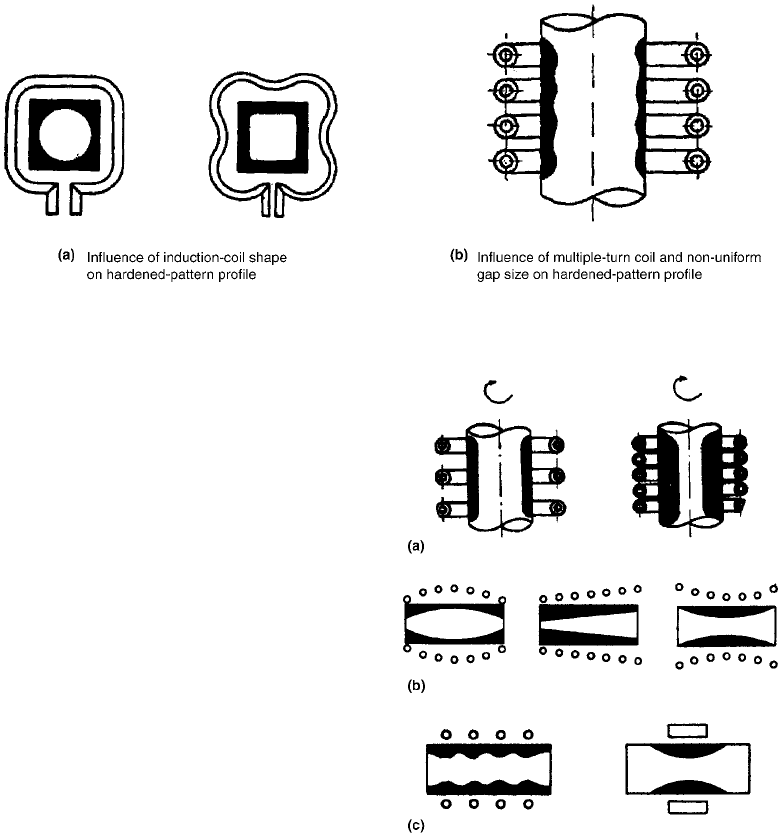
method of heating, that is, hardening. With the
single-shot heating method, the induction coil
may be adapted by choosing an adequate pipe
cross section and by adapting the number of
turns used so as to provide simultaneous heating
of the entire area at the machine part. Figure 4
shows the influence of the induction coil shape
on the heating profile (Fig. 4a) and that of the
distance between the individual turns of the
induction coil and the gap on the heating profile
(Fig. 4b).
The concentration of the heat generated in the
machine part heated by the induction coil is
symmetrically and uniformly distributed across
the cross section, so that no distortion of the part
may occur after quenching. The symmetry of the
hardened-pattern profile thus reduces the risk of
distortion of the machine part. The induction
coils are made of pure copper, which can be
nicely shaped as required to produce coils. Be-
cause the electrical conductivity of the material
is reduced due to plastic deformation of the
material, it is necessary to adequately anneal the
coils to soften the material. Thus, the highest
possible electrical conductivity is ensured. It is
also necessary to prevent the formation of cop-
per oxide at the coil surface to preserve highest
possible electrical conductivity of the material.
This will provide a high efficiency of induction
heating.
In single-shot induction heating, that is,
induction surface hardening, it is important to
provide the same gap size all around the cylin-
drical machine part. Because such an arrange-
ment can be very exacting, the heating process is
usually performed with the rotation of the
machine part. Figure 5(a) shows single-shot
hardening performed with a different number of
inductor turns along the specified hardened
pattern. This means different divisions among
the individual coil turns. Under the same heating
conditions, considerable difference in the
hardened-pattern depth will be obtained with
the same heating time.
Figure 5(b) shows different examples of
shaping a multiple-turn induction coil around
the cylindrical machine part. The figure indi-
cates that the gap size along the cylindrical part
changes, which produces different hardened-
pattern profiles. Figure 5(b) shows the influence
Fig. 4 Influence of shape and arrangement of induction coil around machine part on heating, that is, hardened-pattern profile
Fig. 5
(a) Influence of multiturn coil on hardened-pattern
profile. (b) Influence of shape and gap size of induction
coil turns on hardened-pattern profile. (c) Influence of number of
induction coil turns on hardened-pattern depth
424 / Failure Analysis of Heat Treated Steel Components
Name ///sr-nova/Dclabs_wip/Failure_Analysis/5113_417-501.pdf/Chap_13/ 18/8/2008 3:58PM Plate # 0 pg 424
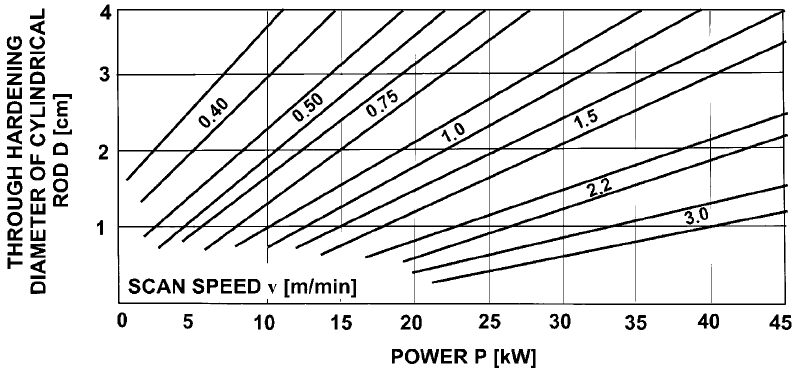
of a multiple-turn coil with too-large divisions of
the individual coil turns; therefore, the same heat-
ing depth, that is, hardened-pattern depth, along
the coil length is not achieved. Thus, individual
coil areas showing a smaller hardened-pattern
depth are obtained at the machine part.
Figure 5(c) shows the influence of the cross
section of a single-turn coil on the hardened-
pattern profile.
For hardening of axles, shafts, and similar
lengthy machine parts, the scan-hardening pro-
cess with a single-turn coil of an adapted cross
section is chosen. Such a hardening process is
necessary, otherwise, high-energy densities and
very long multiple-turn induction coils would be
needed. Figure 6 shows a diagram of heating, that
is, through hardening, of a cylindrical rod of
different diameters (D, in centimeters) with dif-
ferent inductor powers (P, in kilowatts), and a
given frequency ( f, kilohertz) and inductor
movement (v, in cm/s). The diagram shows a
linear dependence between the connected power
at the coil and the depth of hardening, which
means that the choice of a higher power produces
hardening at a greater depth, the movement
velocity being the same. It can also be established
which diameters of the axles or shafts can be
through hardened if the same power is available
and different movement velocities are chosen.
It is possible to distinguish between:
Single-shot hardening
Scanning or progressive hardening
Tooth-by-tooth hardening or gap-by-gap
hardening
Quenching techniques are an important
design feature of induction-hardening equip-
ment. The important questions to be answered
when determining quenching systems include
(Ref 2, 17, 23, 24):
Workpiece size and geometry
Hardenability of steel
Type of austenitizing operation (surface or
through hardening)
Type of heating method (single-shot or
scanning)
Type of quenchant
The two most common types of systems
consist of spray quench rings and immersion
techniques. When quench rings are used for
round bars, their shape, like the coil, is generally
round (Ref 2, 23, 25). Figure 7 shows different
ways to single-shot harden the surface layer.
Common to all of them is that heating is
performed along the length of the layer, so that
the induction coil embraces the particular part of
the workpiece where heat treatment is to be
performed (Ref 15, 16). The ring may be located
concentric with the coil (Fig. 7c) or directly
underneath or alongside it (Fig. 7b), as in the
single-shot induction hardening setup.
In any of these ways, it is important to ensure a
constant gap size between the induction coil and
the workpiece surface. This is usually achieved
by a rotating motion of the workpiece. In the first
case, shown in Fig. 7(a), the cooled induction
coil embraces the object at a certain height. After
heating to the austenitization temperature is
Fig. 6 Selection of heating conditions in scan hardening to provide through hardening of a cylindrical rod
Induction Hardening / 425
Name ///sr-nova/Dclabs_wip/Failure_Analysis/5113_417-501.pdf/Chap_13/ 18/8/2008 3:58PM Plate # 0 pg 425
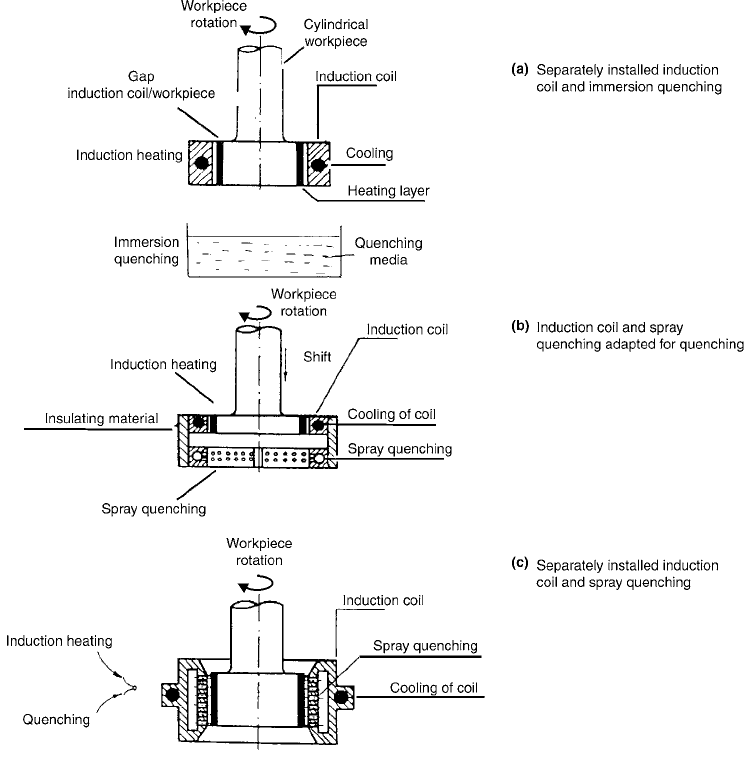
completed, the workpiece is quenched in a
quenching bath, or quenching is done by moving
the workpiece into the quenching spray located
beneath the induction coil (Fig. 7b). Figure 7(c)
shows a method of heating and cooling in the
induction coil, which is made so that it enables
heating of the workpiece surface for a certain
period, and then, on switching the current off, the
same coil is activated as a spray for quenching.
The induction coil is usually made of copper
tubing with additions of alloying elements
that do not affect the electrical conductivity of
copper but contribute to good machinability
of the material. Good machinability is required
because it is necessary to make the openings
for the quenching spray. Thus, during the entire
heat treatment, the workpiece is rotating, and in
this way, uniform heating and quenching are
ensured. The heating and quenching conditions
created in this way produce a uniform hardened
surface layer and ensure repeatability of thick-
ness and shape of the hardened profile.
In induction scanning or progressive hard-
ening, workpieces move through the quench ring
and coil, with quenching occurring immediately
after heating (Fig. 8). For nonsymmetric work-
pieces, the quenching system, like the coil, is
generally the same shape as the workpiece (Ref
15, 16).
The second method of induction hardening
involves a group of procedures of progressive
or progressive-rotating hardening. This type of
Fig. 7 Single-shot induction surface hardening of a cylindrical workpiece. Source: Ref 15, 16
426 / Failure Analysis of Heat Treated Steel Components
Name ///sr-nova/Dclabs_wip/Failure_Analysis/5113_417-501.pdf/Chap_13/ 18/8/2008 3:58PM Plate # 0 pg 426
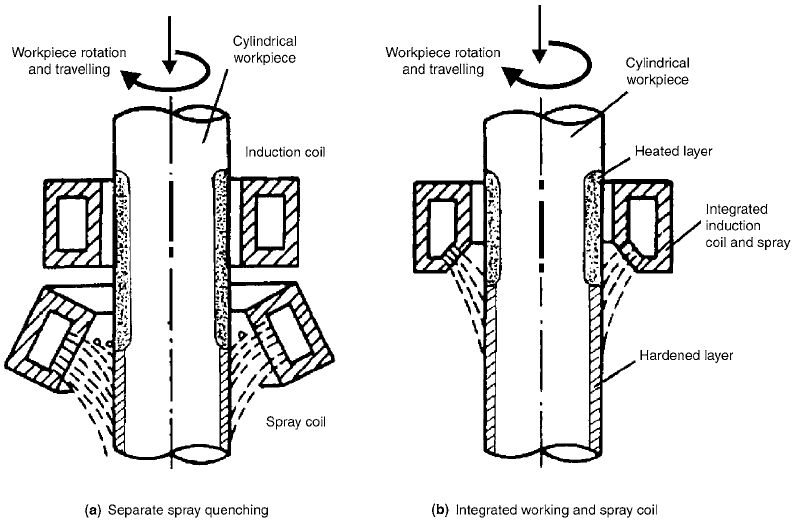
hardening is employed when the required length
of the hardened surface is longer than the length
(size) of the coil. In this case, the correct heating
mechanism can be ensured by the optimal in-
duction coil design (number of coil turns, length
of the coil) and suitable energy inputs for a given
size and profile of the hardened layer (Ref 23,
25, 26). To ensure the uniformity and repeat-
ability of the hardened layer, progressive motion
of the induction coil must be provided, or the
workpiece is fed progressively through the coil
while rotation of the workpiece takes place at the
same time. This method of induction hardening
is presented in Fig. 8. It is possible to design the
induction coil separately from the spray (Fig. 8a)
or combined so that the induction coil has
downward-directed spray openings for quench-
ing in its bottom part (Fig. 8b).
Gear wheels belong to very demanding
machine elements, from the point of view of
mechanical machining as well as heat treatment.
In hardening smaller gears, that is, gears with
small modules or small diameters, the method of
single-shot hardening can be used to ensure a
varying thickness of the hardened layer (Ref 15,
16). The thickness is maximum on the tooth tip
and then decreases toward the tooth root.
Figure 9(a) shows single-shot hardening of tooth
tips, where the coil encircles the whole gear.
This method is very simple and suitable for high-
frequency heating of gears with a module up
to 3 mm and for smaller gear diameter. In this
case, it must be ensured that the tooth flanks are
hardened at least along the length that is other-
wise activated in the mesh, since the thickness of
the hardened layer varies, being highest at the
tooth tip and gradually decreasing toward the
tooth root. This method of hardening is suitable
only for gears subjected to low loads, just to
increase the wear resistance of the gear (Ref 16,
23, 26, 27).
Figure 9(b) shows induction surface hard-
ening, where the whole tooth and a certain area
below the tooth root are hardened. This method
of induction surface hardening is appropriate for
gears with a module up to 5 mm. Heating is
achieved by two systems: first, with a current of
medium frequency, and then in the final phase
for a relatively short period by heating with a
high-frequency current. By quenching, a desir-
able hardness of the tooth flank surface and
increased strength of the gear tooth can be
achieved. In the root of the tooth, due to a refined
microstructure, an increased material fatigue
Fig. 8 Progressive induction hardening of a cylindrical workpiece. Source: Ref 16
Induction Hardening / 427
Name ///sr-nova/Dclabs_wip/Failure_Analysis/5113_417-501.pdf/Chap_13/ 18/8/2008 3:58PM Plate # 0 pg 427
